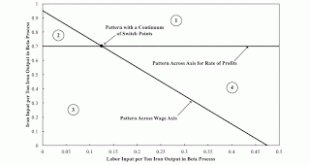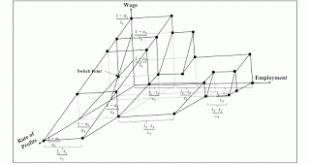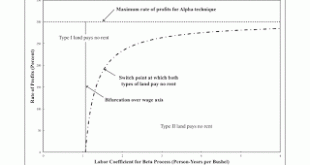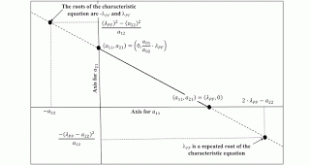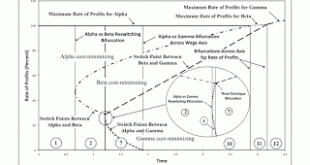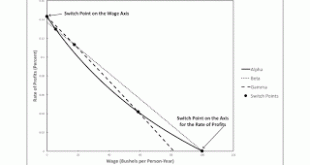Figure 1: A Partitioning Of The Parameter Space1.0 Introduction I consider here a case where two different techniques have the same wage curve. A simple labor of theory of value describes prices in the case under consideration. I treat the labor coefficient and another coefficient of production for a process in one technique as parameters. And I look at what happens when they vary. A note on terminology: on the basis of expert advice and peer review, I am no longer using the term...
Read More »A Neoclassical Labor Demand Function?
Figure 1: A Labor Demand Function1.0 Introduction I am not sure the above graph works. I could draw three-dimensional graphs in PowerPoint, for models specified with algebra, where relative sizes are indefinite. But, I would need to be able to draw parallel lines, and so on. This post presents a model of extensive rent, with one produced commodity. A labor demand function, for a given rate of profits, graphs real wages versus employment. The resulting function is a non-increasing step...
Read More »An Example of Bifurcation Analysis with Land and the Choice of Technique
Figure 1: A Bifurcation Diagram1.0 Introduction I have been looking at how bifurcation analysis can be applied to the choice of technique in models in which all capital is circulating capital. In my sense, a bifurcation occurs when a switch point appears or disappears off the wage frontier. A question arises for me about how to apply or visualize bifurcations in models with land, fixed capital, and so on. This post starts to investigate this question by looking at a numerical example of...
Read More »Infinite Number of Techniques, One Linear Wage Curves
Coefficients for First Column in Leontief Input-Output Matrix I have uploaded a draft paper with the post title to my SSRN site. Abstract:This note demonstrates that the special case condition, needed for a simple labor theory of value (LTV), of equal organic compositions of capital does not suffice to determine technology. A model of the production of commodities, with circulating capital and all commodities basic, is analyzed. Given direct labor coefficients and labor values, an...
Read More »Bifurcation Analysis of a Two-Commodity, Three-Technique Technology
Figure 1: A Bifurcation Diagram This post expands on this previous post. The technology is the same, but the rates of decrease of the coefficients of production in the Beta and Gamma corn-producing processes are not fixed. Instead, I consider the full range of parameter values. (I find the graphs produced by bifurcation analysis interesting for this case, but I think a two-commodity example can be found with more pleasing diagrams.) Anyways, Figure 1 shows a bifurcation diagram for the...
Read More »Reswitching Without a Reswitching Bifurcation
Figure 1: A Bifurcation Diagram This post presents another example of bifurcation analysis applied to structural economic dynamics with a choice of technique. This example illustrates: Two reswitching examples appear and disappear without a restitching bifurcation ever occurring, at least on the wage frontier. Two bifurcations over the wage axis arise. At the time each bifurcation of this type occurs, another switch point for the same techniques exhibits a real Wicksell effect of zero....
Read More »Bifurcation Analysis Applied to Structural Economic Dynamics with a Choice of Technique
Variation of Switch Points with Technical Progress in Two Industries I have a new working paper - basically an update of one I have previously described. Abstract: This article illustrates the application of bifurcation analysis to structural economic dynamics with a choice of technique. A numerical example of the Samuelson-Garegnani model is presented in which technical progress is introduced. Examples of temporal paths through the parameter space illustrate variations of the wage...
Read More »Two Techniques, One Linear Wage Curve
Coefficients for Iron-Production in the Leontief Input-Output Matrix I have uploaded a working paper with the post title. Abstract: This note demonstrates that the special case condition, needed for a simple labor theory of value, of equal organic compositions of capital does not suffice to determine technology. Prices do not vary across techniques for both techniques in a numeric example of a two-commodity linear model of production, and they are proportional to labor values. Both...
Read More »An Example With Two Fluke Switch Points
Figure 1: Fluke Switch Points on Each Axis1.0 Introduction I have developed an approach for finding examples in which either two fluke switch points exist on the wage frontier or a switch point is a fluke in more than one way. This post presents a numerical example with two fluke switch points on the frontier. Not all examples generated by this approach are necessarily interesting, although I find the approach of interest. I don't think the example in this approach is all that...
Read More »Structural Economic Dynamics with a Choice of Technique: A Numerical Example
A Bifurcation Diagram with Two Temporal Paths I have a working paper with the post title. Here's the abstract: This article illustrates the application of bifurcation analysis to structural economic dynamics with a choice of technique. A numerical example of the Samuelson-Garegnani model is presented in which technical change is introduced. Examples of temporal paths through the parameter space illustrate variations of the wage frontier. A single technique is initially uniquely...
Read More » Heterodox
Heterodox

